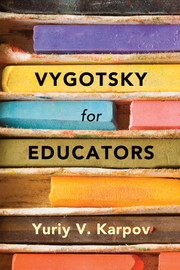Book contents
- Frontmatter
- Dedication
- Contents
- List of Figures
- Acknowledgments
- Introduction
- Part I Mediation from Birth through Adolescence
- Part II School: What to Teach and How to Teach
- 8 American Cognitive Psychologists and Russian Vygotskians talk about the Content and Process of Learning at School
- 9 What Do Students Learn in “Traditional” Schools?
- 10 Does Constructivist Instruction Present a Good Alternative to “Traditional” Teaching?
- 11 The Vygotskian Theoretical Learning Approach as an Alternative to “Traditional” Explicit Instruction and to Constructivist Instruction
- Conclusion
- Notes
- Index
10 - Does Constructivist Instruction Present a Good Alternative to “Traditional” Teaching?
Published online by Cambridge University Press: 05 June 2014
- Frontmatter
- Dedication
- Contents
- List of Figures
- Acknowledgments
- Introduction
- Part I Mediation from Birth through Adolescence
- Part II School: What to Teach and How to Teach
- 8 American Cognitive Psychologists and Russian Vygotskians talk about the Content and Process of Learning at School
- 9 What Do Students Learn in “Traditional” Schools?
- 10 Does Constructivist Instruction Present a Good Alternative to “Traditional” Teaching?
- 11 The Vygotskian Theoretical Learning Approach as an Alternative to “Traditional” Explicit Instruction and to Constructivist Instruction
- Conclusion
- Notes
- Index
Summary
A broad dissatisfaction with learning outcomes of American students has resulted in rejection by many American educators of traditional explicit instruction, where a teacher directly teaches students the knowledge to learn, and advocacy instead of constructivist instruction. Strongly influenced by writings of Piaget and Dewey, the main idea of constructivist instruction is that scientific knowledge should not be taught to students directly; rather, this knowledge should be discovered by students themselves in the course of carrying out some kind of research activity. This idea has been promoted by advocates of constructivist instruction for half a century with some modifications. In the 1960s, constructivists advocated students’ independent pure discovery learning. Starting in the 1990s, many of them have abandoned radical constructivism and “have argued in favor of a middle ground between didactic teaching and untrammeled discovery learning, that of ‘guided discovery’.” Also, influenced in particular by Vygotsky’s theory wrongly understood (this issue is discussed later), they have advocated the idea of discoveries made by a group of students (often referred to as “communities of practice” or “communities of learners”) rather than by individual students alone. In their view, a group of students involved in guided discovery is similar to a group of research collaborators solving a scientific problem by doing research and sharing their ideas, whereas the role of the teacher is to orchestrate students’ discovery processes and “to challenge the learner’s thinking – not to dictate or attempt to proceduralize that thinking.”
Does Constructivist Instruction Work?
The general ideas presented in the opening paragraph have become the basis for the development of numerous constructivist instructional programs known as problem-based learning, project-based learning, inquiry-based learning, or discovery (guided discovery) learning. As a contemporary researcher has observed, “requiring students to discover knowledge rather than explicitly providing them with essential information has become a dominant teaching paradigm.” Does constructivist instruction resolve the problems and overcome the shortcomings of traditional direct instruction? To answer this question, let us first analyze the validity of theoretical assumptions that underlie constructivist instructional programs.
- Type
- Chapter
- Information
- Vygotsky for Educators , pp. 168 - 184Publisher: Cambridge University PressPrint publication year: 2014



